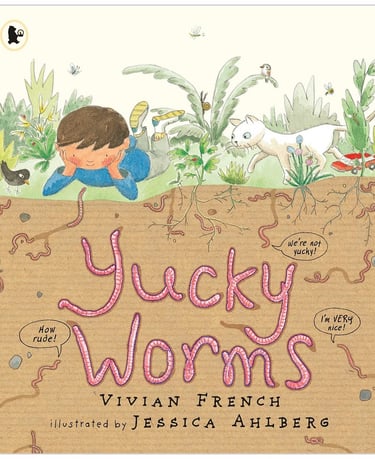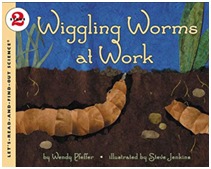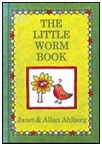ALL YOUR WORMY QUESTIONS ANSWERED
What are some fun facts about earthworms for kids?

1. What is the lifespan of an earthworm?
The lifespan of an earthworm is around 4-8 years, depending on species.
2. How many hearts does a worm have?
A worm has 5 hearts! Although these are different to a human heart, they have 5 little pumps to push blood around the body.


3. What are the main characteristics of earthworms?
An earthworm has a soft, tubular, segmented body that is usually pinkish brown.
They live underground, in burrows, and need moisture to breathe.
They are covered in mucus to help them slide through the mud and have bristles to help them grip.
They are cold blooded and cannot regulate their own temperature.
They have both male and female reproductive organs.
They do not have ears or eyes but can taste, sense light and feel vibrations.
They eat mud and decomposing organic matter, such as leaves.
Their poo is rich in nutrients that help plants to grow.
Worms are source of food for many predators.
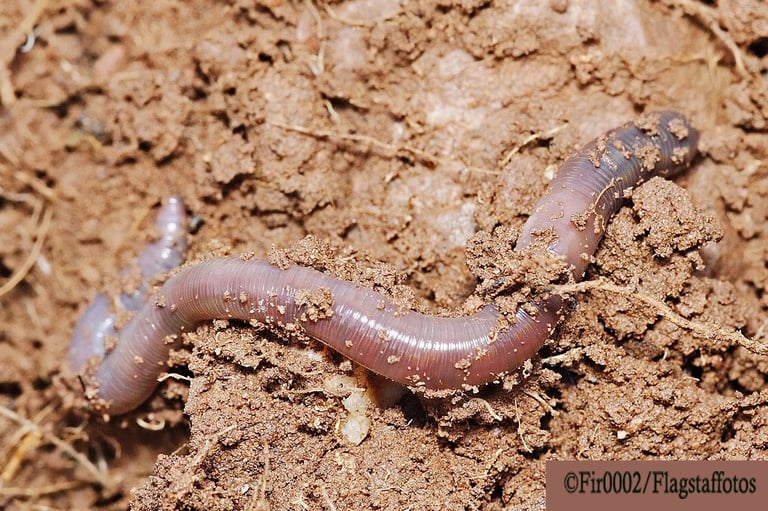

4. Can worms drown?
No. Worms can not drown as they don’t have lungs. Charles Darwin kept a worm in water for 4 months. But a worm will suffocate once all the oxygen in the water has been used. Earthworms cannot swim and their ideal environment is in soil where they can live, eat and socialise, happily. There are, however, worms that live everywhere. Lugworms live under the sand at the beach, and there are even worms that live in toxic springs inside sulphur caves.
5. Are worms intelligent?
Darwin tried to measure the intelligence of worms, and discovered many of their behaviours are instinct. But Darwin did discover they can assess an object (leaf or piece of paper) and select the pointiest end to pull into its burrow. This implies a certain amount of thinking.
6. What do worms eat?
Earthworms eat leaves and organic decaying matter. Charles Darwin found his worms’ favourite leaves were cherry and celery and they were not so keen on strong herbs such as sage, mint and thyme.
Earthworms happily eat mud while they’re burrowing and also eat small stones to help grind the other food in their tummies. Worms will eat meat and any decaying matter, even other worms! But leaves are their favourite!
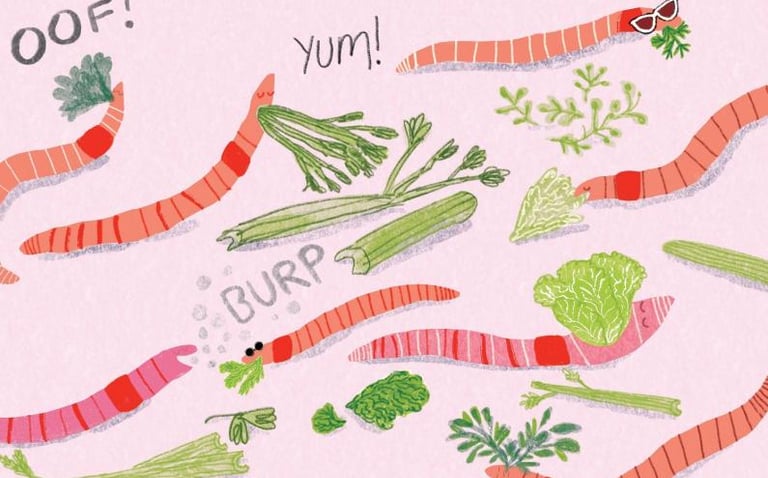

7. Can worms see?
Worms do not have eyes so they cannot see. They have a sense of direction (forwards and backwards) and can move up and down through their burrows. Their sensitive skin detects predators (through vibrations) and sunshine (through light sensors), so they can avoid danger. A worm taken from its burrow will not find its way back and will start a new burrow.


8. Can worms hear?
Earthworms do not have ears so they cannot hear like we can. Charles Darwin played a low bassoon and a high whistle to earthworms, with no reaction. However a worm’s skin can detect vibrations, such as the movement of nearby predators.


9. Are worms insects?
No. Worms are not insects, reptiles or amphibians, they are annelids. Worms share some traits with insects (they are invertebrates, so do not have a back bone), and some traits with selected amphibians (they can breathe in water), but they are a unique group (phylum) of animals called annelids. There are over 22,000 different species of annelids which includes leeches and ragworms. Note: Ringworm (fungus), woodworm (beetle larva) and tapeworms (parasite) are not annelids.


Annelids:
A) Earthworm © Fir0002/Flagstaffotos https://commons.wikimedia.org/wiki/File:Earthworm.jpg B) Ragworm © Hans Hillewaert. https://commons.wikimedia.org/wiki/File:Alitta_virens_(head).jpg C) Leech © Shizhao. https://commons.wikimedia.org/wiki/File:Leech-china.JPG
10. Are worms good for plants?
Yes! Plants that grow in a soil rich in worm poo have all the nutrients they need. Leaves and waste are quickly broken down by worms to create a plant super-booster called humus.
This nutritiously rich humus contains: carbon, calcium, nitrogen, potassium, phosphorus, iron, sulphur, magnesium, zinc, copper, calcium, manganese, sodium and many bacteria and fungi.


11. Are worms hermaphrodites?
Yes. Worms contain both male and female body parts. So both can lay eggs and be the mum or the dad!
12. Can earthworms survive in winter?
Earthworms that live underground will burrow deeper during frost and snow to stay warm. Surface dwelling worms that are exposed to freezing temperatures will mostly die, but their eggs will survive. Some worms can survive freezing temperatures and a cousin of the earthworm called the ‘iceworm’ can live in glaciers (frozen ice, snow and rock).
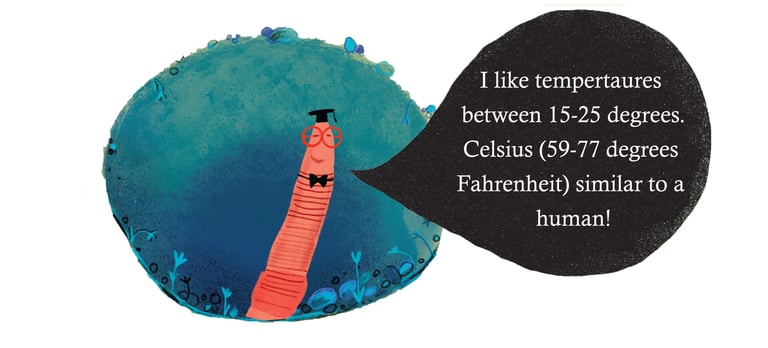

13. Are worms good for the soil?
Yes! In Victorian times people thought worms were bad for the soil. But thanks to Charles Darwin’s work, we now know they eat up organic waste on the surface, deposit nutrients, aerate the soil with their tunnels and help water drainage.
14. What do earthworms do all day?
Worms love to tunnel and eat! They can eat 1/2 their body weight in food each day. They are sociable and will lie next to each other in burrows. They will also rest, being most active at night.

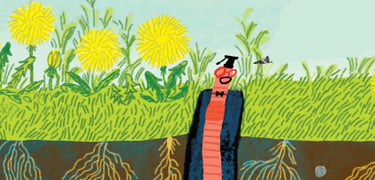
15. Why are worms important?
All animals, including us, eat plants, and plants need soil to grow. Worms break down organic matter and create a rich, nutritious soil with their poo. Life on earth would struggle to exist without it. And let’s not forget all the birds, badgers and other animals that eat worms as part of their diet!
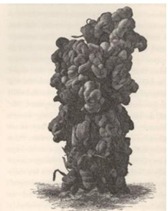

© The Formation of Vegetable Mould through the Action of Worms, with Observations on their Habits
16. Why do worms come out when it rains?
Nobody knows exactly why worms come out when it rains. There are a few theories and one of the most popular is that worms choose this time to travel across the grass, for a new habitat, food or a mate. A worm’s skin must always be moist to breathe, so wet conditions are the safest to leave their burrow.
17. Do worms come out at night?
Yes. Worms are most active at night and avoid the sun that can dry out their skin. Worms are also sensitive to the sun's UV rays which are present even on cloudy days.


18. Do worms sleep?
Worms definitely rest, and can be found curled up in their burrows, particularly in the day or when soil conditions are not good. But worms do not have a long period of sleep like a human would.
19. What eats worms?
Birds, foxes, badgers, hedgehogs, weasels, stoats, otters, shrews, mink, raccoons, skunks, moles, mice, rats, frogs, toads, Snakes, lizards, beetles, centipedes, slugs, ants and snails.


20. Can earthworms make you sick?
Earthworms can’t make you sick by touching them. There are lots of types of worms and some of these can live in the human body and make you ill, like a tapeworm. But earthworms are important for the plants humans need to survive, and they are safe to touch.
Eating earthworms raw is not safe for humans or some animals as they may have other parasites living in them.


21. Are earthworms poisonous to animals?
Earthworms are not poisonous, and are eaten by many animals. However, earthworms sometimes eat roundworm eggs, which if eaten by a dog, could make them ill.


22. Can earthworms regenerate?
An injured earthworm can regrow some of its segments, particularly at the tail end. This varies by species, and the more segments lost, the less likely it will survive. So be careful when digging!
23. Is a worm an invertebrate?
Yes. A worm does not have a spine or a hard skeleton. It is 100% pure muscle!
24. Are earthworms cold blooded?
Yes. Earthworms are cold blooded. They cannot regulate their own temperature. Luckily the soil is good at staying a constant temperature, even in the sun and snow.
25. Can earthworms bite?
No. Earthworms do not have teeth. The eat stones to grind the food in their tummies. Worms also have a lip and produce a liquid to help digest their food.
26. How many babies do worms have?
Worms lay one cocoon or egg casing, containing 1-20 eggs. The average number is 4, and many species have just one baby.
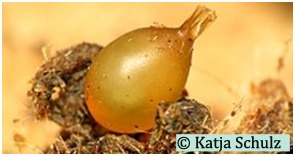

27. How far down do earthworms live?
There are different types of earthworms. Some live on the surface, some just below and others deep down. The deep burrowing worms can go as deep as 2 metres!
28. Is plastic grass bad for worms?
Yes, plastic grass is bad for worms and all wildlife. The plastic restricts access to the surface of the soil. Nobody knows how this will affect the worms. Any plastics eaten will be bad for the worm, and the micro plastics excreted will be mixed into the soil. If the worms are eaten by a predator, such as a mole, they will also ingest the plastics. Birds and animals living above ground will not be able to find worms to eat.

29. How long was the longest earthworm?
The longest earthworm ever found was 6.7 metres, from South Africa (1967). Giant earthworms (1 metre or more) can be found in Africa, Australia, New Zealand, Southeast Asia and India.
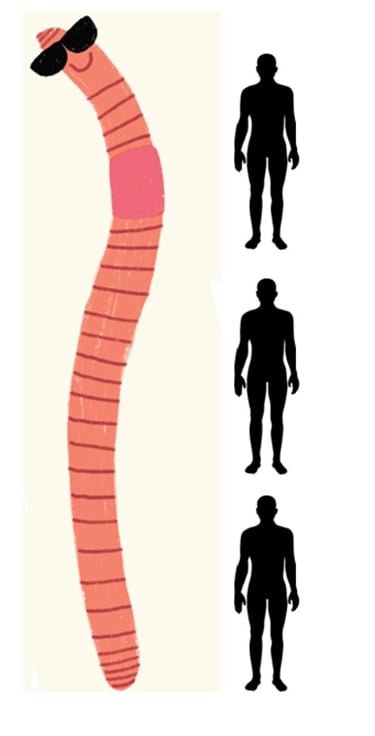

30. What is a good children's book about worms?
Darwin’s Super-Pooping Worm Spectacular is perfect for ages 6+. It follows Charles Darwin’s 40 year study of earthworms and all the things he learnt through his fun experiments, including the discoveries he made about their poo! The story supports the national curriculum and K-5 in the following areas: STEM, mini-beasts, soil, plants, designing experiments, drawing conclusions, people who made a difference, resilience, perseverance and composting.
Bookshop.org
And for adults... the most in depth, detailed study of an earthworm’s behaviour and senses, is The Formation of Vegetable Mould Through the Action of Worms, with Observations on their Habits, by Charles Darwin, 1887. Who also documented how landscapes evolved through the actions of worms.
All illustrations, not otherwise specified, are from Darwin's Super-Pooping Worm Spectacular ©Quarto, illustrations ©Gwen Millward, text ©Polly Owen.



